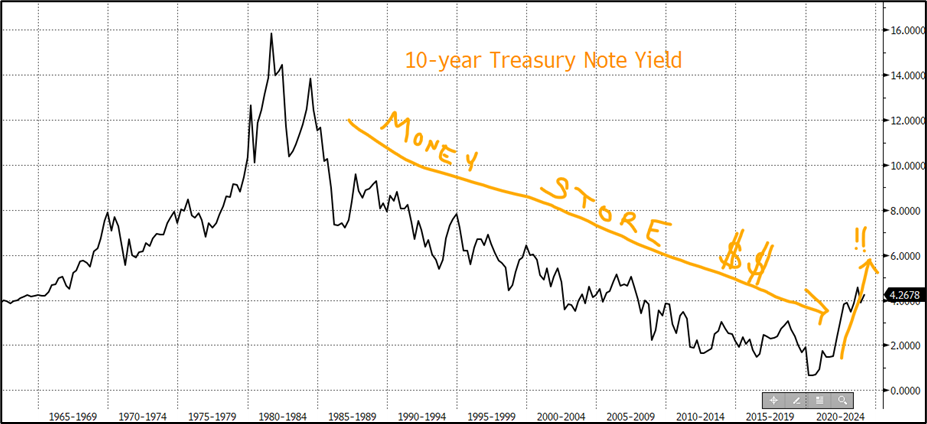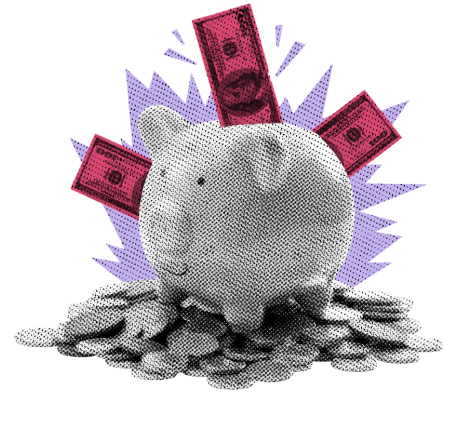
Stocks struggled to hold onto early gains yesterday on a day with very little to contemplate other than that nagging fear that the Fed is just not going to give traders a break… any time soon. New Home Sales disappointed yesterday pointing to higher interest rates as the cause.
The money store. If you lived in the tri-state area in the 1970s through 2007, you are sure to have seen Hall of Fame Yankee shortstop Phil Rizzuto on TV hawking mortgage lending company The Money Store. Being a Yankees fan I, of course, was happy to see Scooter on the tube, but there was something odd about the commercials. First, what would a baseball player, ALBEIT AN AWESOME ONE, know about money lending? Second, do you remember how high secondary mortgage rates were for most of Rizutto’s “commercial” career? I’ll give you a hint: they were high, really high. And third, you have got to love a name as basic as “The Money Store,” as it would be hard to confuse what the firm’s line of business was. In any case, good ol’ Phil finally retired from TV around 2007 just in time for the entire global financial system to melt down… caused by… um, the mortgage industry.
The Global Financial Crisis that ensued gave way to what I would refer to as The Money Store 2.0. Interest rates were already trending lower leading to the GFC, but the event along with the Fed’s first-time ZIRP (Zero Interest Rate Policy) and QE (Quantitative Easing) ensured a long run of ultra-low rates. Today, many folks refer to those days as the “free money” days. Low rates meant that companies could borrow money from the public, or even banks, at a very low cost.
If a company needs cash it can go to the equity markets and sell stocks or it can go to the debt markets and issue bonds. Despite what many people think, selling stock is not without cost. When a company sells stock to the public, it dilutes its earnings per share (EPS). There is technically no problem with that, but existing shareholders don’t appreciate it, and if it gets too extreme it could cause shareholders to sell… which is usually not a good thing. Additionally, there are the optics. In a very simple example, if a company doubles its outstanding stock and it has an EPS of $2/share it will have an EPS of only $1/share after the new issue. If an investor were off on a world golf tour, came back and saw that her favorite stock’s EPS had declined by -50%, she might be a bit… er, disappointed. If the stock is a dividend stock, there may be lower dividends to contend with as well. Generally, and I mean very generally (because there are many, many factors in reality), there are significant costs to issuing stock.
Knowing that stock issuance is expensive and how interest rates were very low in the wake of the GFC, it probably makes sense to you that corporate treasurers borrowed lots AND LOTS of money from the public debt markets leading up to… you guessed it, 2022. In fact, borrowing was so cheap that companies sold debt to pay high dividends and to fund stock buybacks. Stock buybacks, incidentally, have the opposite effect of stock offerings on EPS. EPS increases as outstanding shares decrease, keeping actually earnings constant. File that under “it’s just math, stupid.”
Now that 10-year interest rates are back to pre-GFC levels, corporate treasurers’ decision inputs are changing. With many companies’ stocks at high valuations, it may be cheaper to issue stock than to take on higher-yielding debt. Of course, one cannot generalize that statement as there are many factors that go into the decision. I simply would like to point out that the calculus has changed, so that you won’t be surprised to see more secondary offerings out there in the quarters to come. Especially given that it appears that these yield levels may be here for a while longer.

WHAT’S CHEAP THIS MORNING
Lowe’s Cos Inc (LOW) shares are lower by -0.49% after it announced that it beat EPS and Revenue estimates last quarter. However, sales are down year over year and management expects sales to continue to soften throughout 2024, blaming the pullback on high mortgage rates. We heard a similar story from Home Depot (HD) in its release last week. Lowe’s forward PE of 17.84x is cheaper than the 24.00x PE of rival Home Depot. Dividend yield: 1.90%. Potential average analyst target upside: +1.5%.
AutoZone Inc (AZO) shares are higher by +1.97% in the premarket after the company announced that it beat EPS and Revenue estimates by +9.98% and +0.40% respectively. The company did disappoint on same store sales. Of the analysts that cover the company, 75% rate the company as a BUY, 21.4% rate it a HOLD, while Morningstar is the only company that rates the company a SELL. Potential average analyst target upside: +6.8%.
YESTERDAY’S MARKETS

NEXT UP
- Durable Goods Orders (Jan) may have slipped by -5.0% after breaking even in December.
- FHFA House Price Index (Dec) is expected to have increased by +0.3% for a second straight month.
- Conference Board Consumer Confidence (Feb) may have increased slightly to 115.0 from 114.8.
- Fed Vice Chair Michael Barr will speak today.
- After the closing bell earnings: Rocker Lab, Splunk, Beyond Meat, Coupang, Vizio Holdings, eBay, First Solar, Devon Energy, and Agilent.
.png)

